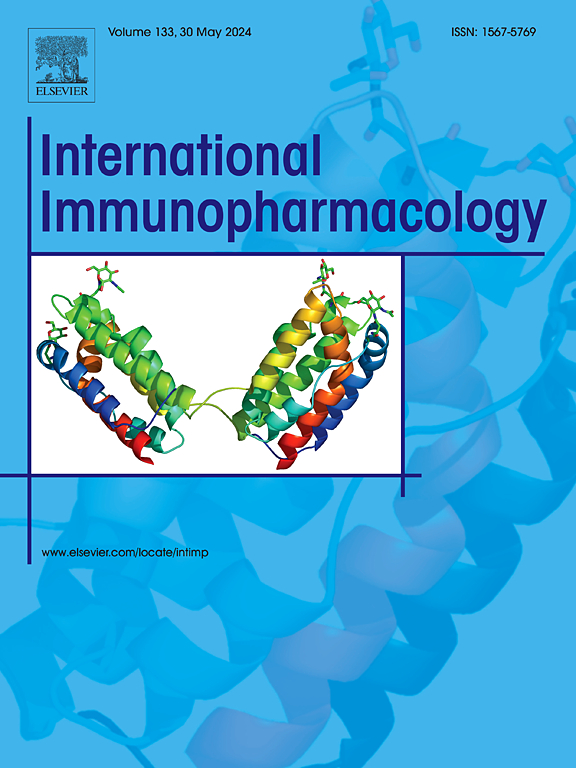新型抗PD-L1 DNA适配体Apta35通过肺癌激活的T淋巴细胞增强非小细胞肺癌细胞的细胞毒性和凋亡能力
IF 4.8
2区 医学
Q2 IMMUNOLOGY
引用次数: 0
摘要
程序性死亡配体 1 (PD-L1) 在非小细胞肺癌患者中普遍存在,通过抑制免疫细胞上的 PD-1 受体或肿瘤和/或免疫细胞上的 PD-L1 配体来阻断 PD1/PD-L1 通路可以抑制肿瘤生长。EFBALite 算法可以高效、经济地选择适配体,从而加快这一过程。在此,我们介绍了靶向 PD-L1 的 DNA 适合物的开发、计算验证和 NSCLC 体外分析。Apta35和Apta90这两种抗PD-L1适配体的吉布斯自由能分别为-3.06和-2.4 kcal/mol。在 HDOCK 和 ZDOCK 中,Apta35 的对接得分分别为-272.3 和 1171.765。此外,由于 Apta35 更为稳定,我们将其与 NCI-H460 一起进行体外研究。最初,我们通过显微成像确认了 TAMRA 标记的 Apta35 与 NCI-H460 细胞表面的结合,并通过 FACS 分析进一步确认了这一点。进一步的实验结果表明,与浓度为 50 nM 的 act-T 细胞处理组相比,与 act-T 细胞一起处理的 Apta35 可降低 NCI-H460 细胞的存活率(28 ± 3.5)、增加毒性并减少细胞数量。总之,用特异性适配体靶向 PD-L1 为靶向 NSCLC 提供了一种创新策略。在每两天注射一次共 12 天的治疗过程中,Apta35 合物在 BALB/c 裸鼠体内没有显示出明显的毒性。本文章由计算机程序翻译,如有差异,请以英文原文为准。

A novel anti-PD-L1 DNA aptamer, Apta35 enhances non-small cell lung cancer cell cytotoxicity and apoptosis through lung cancer-activated T lymphocytes
The prevalence of Programmed death ligand 1 (PD-L1) expression in the population of NSCLC patients and blocking the PD1/PD-L1 pathway by inhibiting the PD-1 receptor on immune cells or the PD-L1 ligand on tumour and/or immune cells can inhibit tumour growth. EFBALite algorithm that enables efficient and cost-effective selection of aptamers, expediting the process. Here, we present the development, computational validation, and in vitro analysis of NSCLC of DNA aptamers targeting PD-L1. The Gibbs free energy of two anti-PD-L1 aptamers, Apta35 and Apta90 with −3.06 and − 2.4 kcal/mol respectively. The docking score for Apta35 was −272.3 and 1171.765 for HDOCK and ZDOCK respectively. Further, the Apta35 was taken for the in vitro studies as it was more stable and incubated with NCI-H460. Initially, we confirmed the binding of the TAMRA-labelled Apta35 to the NCI-H460 cell surface through microscopic imaging and further confirmed through FACS analysis. Further experimental results showed that the Apta35 treated along with the act-T cells group reduced the percentage of viability (28 ± 3.5), increased toxicity, and reduced count of NCI-H460 cells when compared with the cells treated only with the act-T cells concerning the treatment to 50 nM concentration. In summary, targeting PD-L1 with a specific aptamer provides an innovative strategy for targeting NSCLC. Apta35 aptamer showed no significant toxicity in the BALB/c nude mice while it was injected every 2 days for a total of 12 days of treatment.
求助全文
通过发布文献求助,成功后即可免费获取论文全文。
去求助
来源期刊
CiteScore
8.40
自引率
3.60%
发文量
935
审稿时长
53 days
期刊介绍:
International Immunopharmacology is the primary vehicle for the publication of original research papers pertinent to the overlapping areas of immunology, pharmacology, cytokine biology, immunotherapy, immunopathology and immunotoxicology. Review articles that encompass these subjects are also welcome.
The subject material appropriate for submission includes:
• Clinical studies employing immunotherapy of any type including the use of: bacterial and chemical agents; thymic hormones, interferon, lymphokines, etc., in transplantation and diseases such as cancer, immunodeficiency, chronic infection and allergic, inflammatory or autoimmune disorders.
• Studies on the mechanisms of action of these agents for specific parameters of immune competence as well as the overall clinical state.
• Pre-clinical animal studies and in vitro studies on mechanisms of action with immunopotentiators, immunomodulators, immunoadjuvants and other pharmacological agents active on cells participating in immune or allergic responses.
• Pharmacological compounds, microbial products and toxicological agents that affect the lymphoid system, and their mechanisms of action.
• Agents that activate genes or modify transcription and translation within the immune response.
• Substances activated, generated, or released through immunologic or related pathways that are pharmacologically active.
• Production, function and regulation of cytokines and their receptors.
• Classical pharmacological studies on the effects of chemokines and bioactive factors released during immunological reactions.

 求助内容:
求助内容: 应助结果提醒方式:
应助结果提醒方式:


